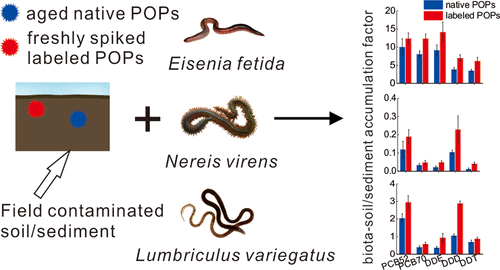当前位置:
X-MOL 学术
›
Environ. Sci. Technol. Lett.
›
论文详情
Our official English website, www.x-mol.net, welcomes your
feedback! (Note: you will need to create a separate account there.)
A Direct Method for Quantifying the Effects of Aging on the Bioavailability of Legacy Contaminants in Soil and Sediment
Environmental Science & Technology Letters ( IF 8.9 ) Pub Date : 2019-02-05 , DOI: 10.1021/acs.estlett.8b00661 Jie Wang 1 , Daniel Schlenk 1 , Jay Gan 1
Environmental Science & Technology Letters ( IF 8.9 ) Pub Date : 2019-02-05 , DOI: 10.1021/acs.estlett.8b00661 Jie Wang 1 , Daniel Schlenk 1 , Jay Gan 1
Affiliation

|
A majority of persistent organic pollutants (POPs) that we see today have in fact undergone extensive aging in the environment, as their use was discontinued several decades ago. While contaminant aging is commonly believed to lead to reduced bioavailability, at present there is not a direct method for quantitatively determining the effect of aging. Here we propose a method based on the addition of isotope-labeled reference compounds to field-collected soil or sediment and comparison of the bioavailability between aged POPs and their freshly added isotope-labeled counterparts. We demonstrated this method using bioaccumulation by invertebrates and 24 h Tenax desorption as bioavailability end points. Compared to the freshly added isotope-labeled references, biota-to-soil/sediment accumulation factors (BSAFs) of native (aged) DDTs (p,p′-DDD, p,p′-DDE, and p,p′-DDT) and PCBs (PCB52 and PCB70) were consistently smaller, indicating that aging decreased their bioaccumulation potential. For two aged soil samples from Florida, BSAFs for earthworm (Eisenia fetida) decreased by 29.3–62.8% for DDT derivatives and 18.3–34.4% for the PCBs. In aged marine and lake sediments from California, BSAFs for indicator invertebrates (Nereis virens and Lumbriculus variegatus) decreased by 19.4–67.5% for DDTs and 12.0–46.9% for the two PCBs. Similar reductions were also observed when the same samples were analyzed using 24 h Tenax desorption. Given that mass spectrometry is widely available, a simple method based on the addition of isotope-labeled analogues may be easily adopted and will be of great value for quantifying aging effects to refine risk estimates of contaminated soil and sediment sites, including the need for remediation intervention.
中文翻译:

定量老化对土壤和沉积物中遗留污染物生物利用度影响的直接方法
我们今天看到的大多数持久性有机污染物(POPs)实际上已经在环境中经历了广泛的老化,因为几十年前就已经停止使用它们。通常认为污染物老化会导致生物利用度降低,但目前尚无直接定量确定老化效果的直接方法。在这里,我们提出了一种基于将同位素标记的参考化合物添加到田间采集的土壤或沉积物中,并比较老化的POPs和其新鲜添加的同位素标记的对应物之间的生物利用度的方法。我们证明了这种方法利用无脊椎动物的生物蓄积和24小时Tenax解吸作为生物利用度终点。与新鲜添加的同位素标记参考相比,天然(老)滴滴涕的生物-土壤/沉积物累积因子(BSAF)(p,p '滴滴滴,p,p '-DDE,和p,p滴滴涕)和多氯联苯(PCB52和PCB70)为一致时,指示老化降低他们的生物蓄积性。对于来自佛罗里达州的两个老化土壤样品,D(Eisenia fetida)的BSAF对于DDT衍生物下降了29.3–62.8%,对于PCBs下降了18.3–34.4%。在来自加利福尼亚的老化的海洋和湖泊沉积物中,用于指示性无脊椎动物(Nereis virens和Lumbriculus variegatus)的BSAF)滴滴涕(DDT)下降了19.4–67.5%,两个PCB下降了12.0–46.9%。当使用24小时Tenax解吸分析相同样品时,也观察到类似的减少。鉴于质谱分析法广泛可用,因此可以容易地采用基于同位素标记类似物的简单方法,该方法对于量化老化效应以改进受污染的土壤和沉积物位点的风险估计(包括需要补救)具有重要价值。干涉。
更新日期:2019-02-07
中文翻译:

定量老化对土壤和沉积物中遗留污染物生物利用度影响的直接方法
我们今天看到的大多数持久性有机污染物(POPs)实际上已经在环境中经历了广泛的老化,因为几十年前就已经停止使用它们。通常认为污染物老化会导致生物利用度降低,但目前尚无直接定量确定老化效果的直接方法。在这里,我们提出了一种基于将同位素标记的参考化合物添加到田间采集的土壤或沉积物中,并比较老化的POPs和其新鲜添加的同位素标记的对应物之间的生物利用度的方法。我们证明了这种方法利用无脊椎动物的生物蓄积和24小时Tenax解吸作为生物利用度终点。与新鲜添加的同位素标记参考相比,天然(老)滴滴涕的生物-土壤/沉积物累积因子(BSAF)(p,p '滴滴滴,p,p '-DDE,和p,p滴滴涕)和多氯联苯(PCB52和PCB70)为一致时,指示老化降低他们的生物蓄积性。对于来自佛罗里达州的两个老化土壤样品,D(Eisenia fetida)的BSAF对于DDT衍生物下降了29.3–62.8%,对于PCBs下降了18.3–34.4%。在来自加利福尼亚的老化的海洋和湖泊沉积物中,用于指示性无脊椎动物(Nereis virens和Lumbriculus variegatus)的BSAF)滴滴涕(DDT)下降了19.4–67.5%,两个PCB下降了12.0–46.9%。当使用24小时Tenax解吸分析相同样品时,也观察到类似的减少。鉴于质谱分析法广泛可用,因此可以容易地采用基于同位素标记类似物的简单方法,该方法对于量化老化效应以改进受污染的土壤和沉积物位点的风险估计(包括需要补救)具有重要价值。干涉。











































 京公网安备 11010802027423号
京公网安备 11010802027423号